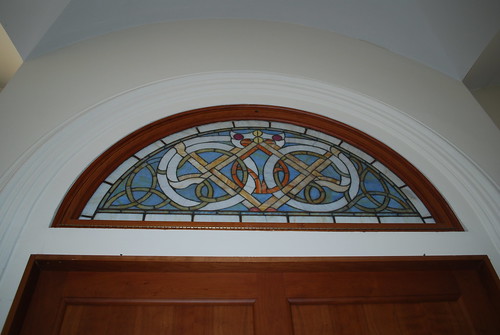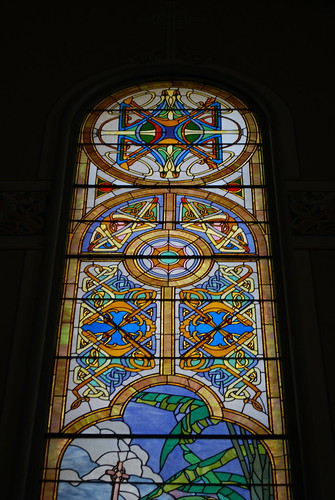It abounds in Old St. Pat's. Transoms above doors bear not so simple Celtic knots.
These are glass, not painted.
They have the defects seen in any stained glass window which has been around for a very long time; cracked pieces and cracking in the leading between the pieces. You can see the tri-cornered design in both of the windows. This is said to represent the trinity; Father, Son and Holy Spirit or Ghost.
When I do buildings containing stained glass, part of my inspection is to record the state of the windows. This means taking full-length views. This is the Annunciation of Mary.
Notice the scrolled design at the bottom of the window.
This is repeated above the main panel.
I like the juxtaposition of the almost watercolor figures with bolder colors on the top and bottom. I could see the circular design at the top of the window done as a rug or a needlework.
Here is the middle of the window; the angel
and Mary.
The faces are painted to give them depth. It's very hard to do stained glass to represent, correctly, the face. Subtle gradations in shade are just hard to do.
I present another window to show the dynamic colors.
I don't remember what this commemorated. It's obviously a priest coming ashore to spread the gospel.
There might have been some identifying plaque near the window, but I don't remember. What I liked about this one was the colorful knots below and above the figures.
Here are the central figures.
Again, their faces were painted onto the glass. The blue and yellow pieces with the color gradients were pieces of glass in their own right. I did not see paint on them.
This is a window in the choir loft.
The emerald green we associate with Ireland is on display here.
There were two side alcoves at the back of the sanctuary. This one contained relics of the saints.
Above it was a stained glass transom.
The south alcove was a mosaic-lined area with a half-dome stained glass ceiling.
There was a sign in front of the alcove giving you a description of each panel and what it meant.
The flash from the camera caused the colored tiles to glow.
Mosaics are amazing creations. I didn't have time to spend to read up on the significance of these panels. I've always wanted to do mosaics. I admire the ability to break a design down to colored pieces of glass and to place those pieces so a larger design emerges.
I do not know if the dome is back lit in any way. It was a bright sunny day when I did the inspection so the colors and intricacies of the dome were clear.
The highlight of the crafter's art was above the altar. In the post below, I showed photos of the general ceiling; the richly detailed painting and the arched choir level with it's multiple paint. The altar area had a massive stained glass panel. It's too big to document in one photo.
These three photos are the middle row.
Isn't that just amazing? The ceiling is reinforced and the window is protected on the outside. I do not know if it's illuminated at night. That would be an amazing sight. Imagine sitting in these pews looking up into color.
Imagine being surrounded by color. In times of anxiety, I can see this spot being a place of rest. I sat in the pews for a moment and they are quite comfortable.
This is a "working" church, meaning it has an active congregation. They had redone the basement to provide better lavatories and an acoustic ceiling in their fellowship hall for music.
They serve a multi-ethnic congregation, although it is most Hispanic now. I had to take all this in and do my job before the noon worship service.
The church encourages people to come and be in the space.While I was there, at least a dozen tourists came, walked about and left. I felt a bit conspicuous when Catholics would come in, take a seat, kneel, and start to pray. Here I am, talking into a tape recorder. "Overviews of window number 3 on the wall 3. Crack in the lower left corner of the frame."
And, no matter how often I do it and no matter how much permission I have, I still feel awkward walking behind or up onto the altar area. It's a place of reverence and respect. Although I feel less religious than in previous years, a feel this space needs to be respected, but I have to do my job. Who is this lady with the tape recorder and the camera taking photos of the side of the altar? It's much better when the church is usually closed and I have to inspect it. Then I don't feel that I'm intruding on another's need for worship.
If you are in the Chicago area and are looking for an off-the-beaten path place of history, come here. The church is open at 9 with a noon worship. I managed to finish my work at 11:50. I saw a lot of people going into the church for that worship. The bells tolled at 11:45 and again at noon. There is a school to the north of the church, but you can't miss this since it's at the corner of Adams and Halsted. You can't count on weather in Chicago but if you get a brilliantly sunny day, you won't be disappointed in the windows.
This is one of the reasons I love my job. I get to be in places like this.
Beverage: Assam tea
Deb






























No comments:
Post a Comment